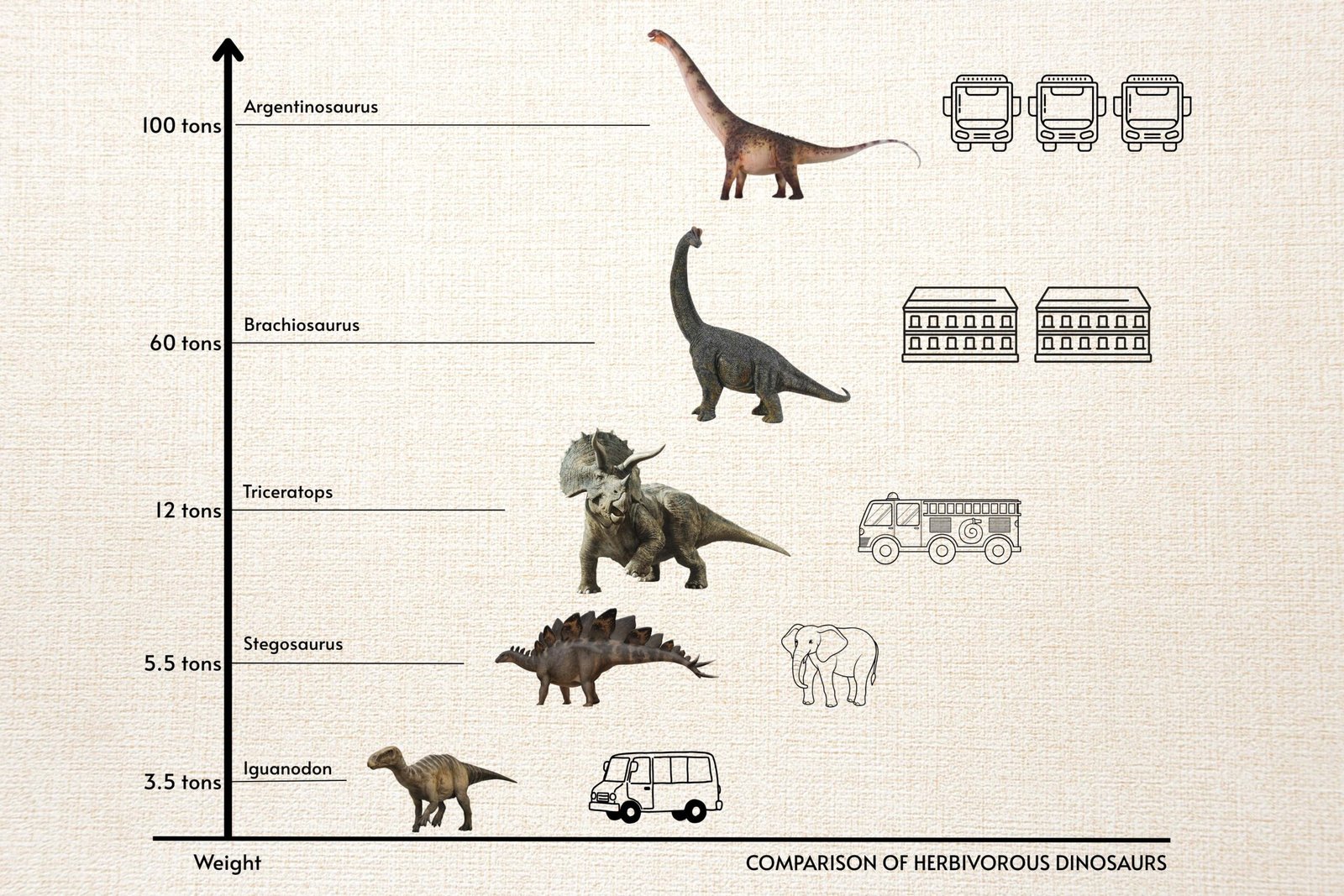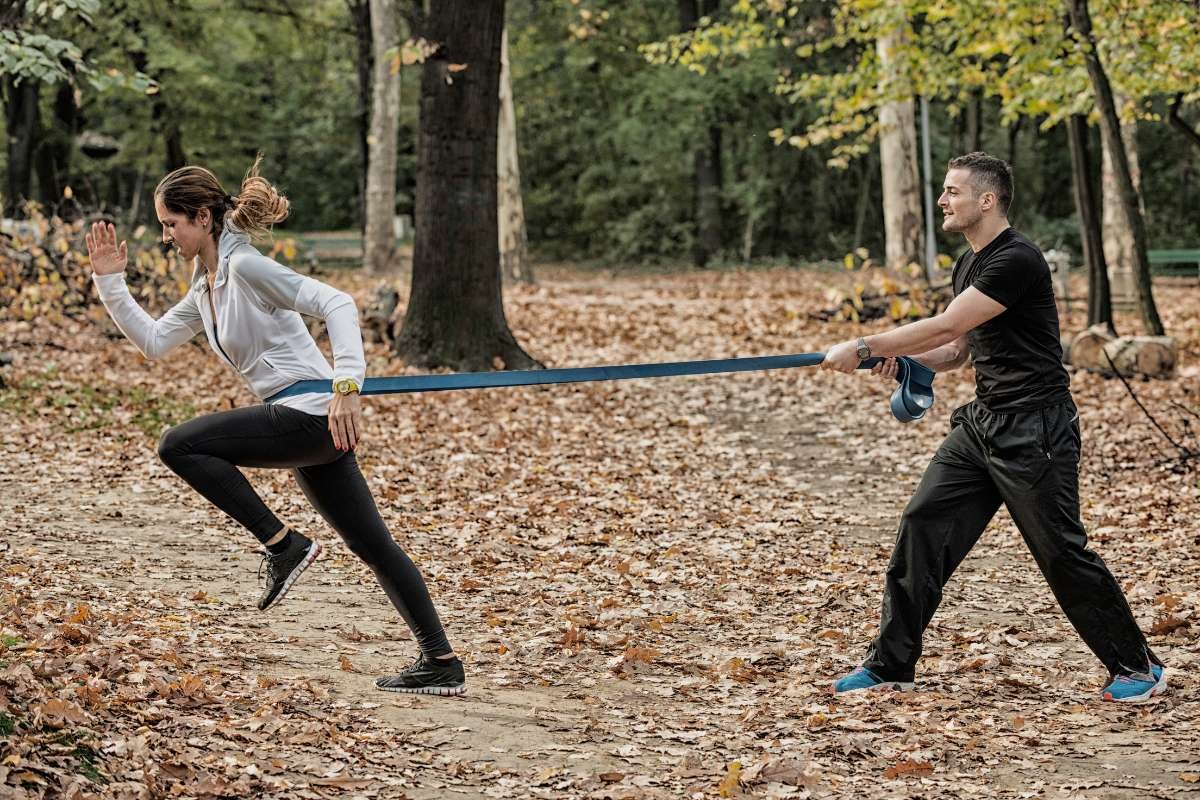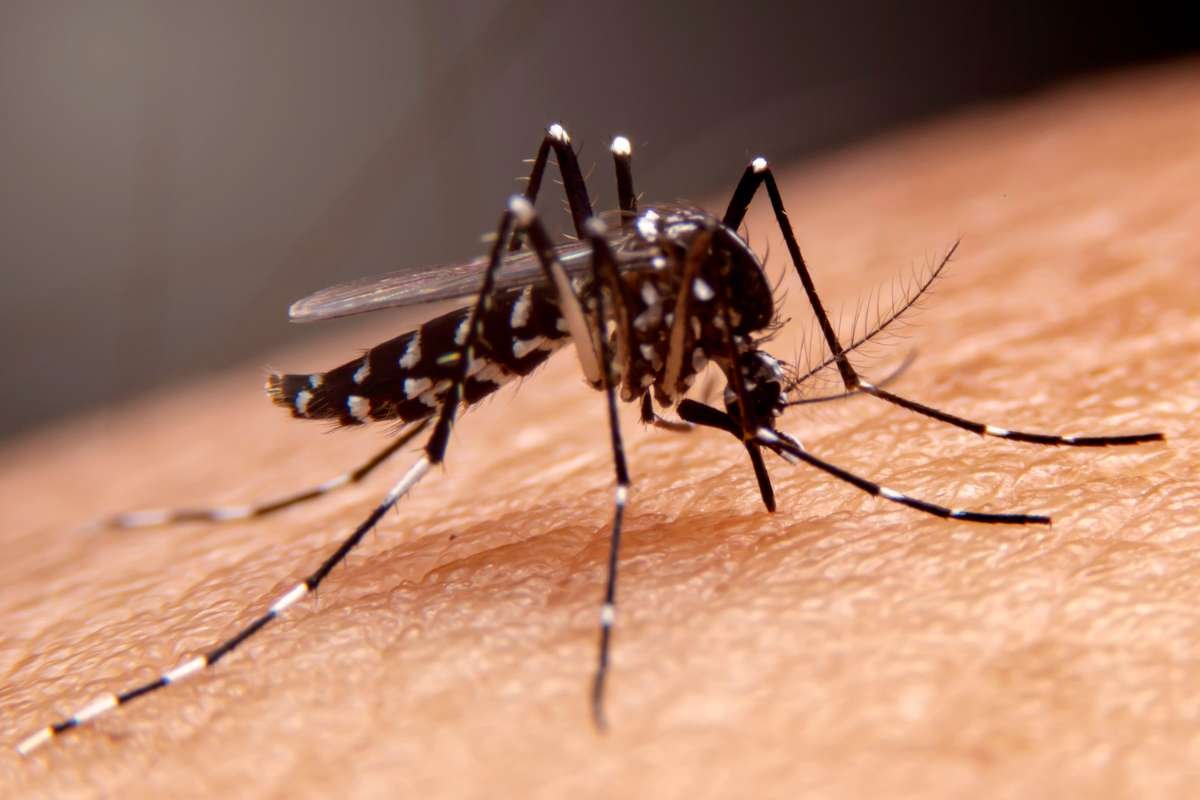Ever felt tiny? Just wait until you meet a dinosaur as tall as three stacked school buses. This isn’t a scene from a movie; it’s a real look at how huge (or small) these ancient creatures were.
Some were no bigger than a chicken, while others were taller than your house. Some ran fast, some stomped slowly, and some just stood around eating plants all day. In this fun Dinosaur size comparison, we will look at 15 amazing dinosaurs, what they ate, meat, plants, or both, and how big they were. Get ready, because this prehistoric adventure is about to begin!
How Were Big Plant-Eating Dinosaurs? Comparison of Herbivorous Dinosaurs

| Dinosaur Name | Height | Length | Weight | Surviving Period (MYA) | Size Compared |
| Argentinosaurus | 70 ft | 120 ft | 100 tons | 94 – 97 | 3 Buses |
| Brachiosaurus | 40 ft | 85 ft | 60 tons | 154 – 153 | 4 – Story Building |
| Triceratops | 10 ft | 30 ft | 12 tons | 68 – 66 | Firetruck |
| Stegosaurus | 14 ft | 29 ft | 5.5 tons | 155 – 150 | African Elephant |
| Iguanodon | 16 ft | 33 ft | 3.5 tons | 140 – 125 | Large Van |
Some were tall as buildings, others carried armor plates. We will dive into herbivorous dinosaurs and see how these peaceful giants measured up in height, weight, and length, from Triceratops to Argentinosaurus.
1. Argentinosaurus
Argentinosaurus was the ultimate heavyweight champion in the dinosaur world. It roamed what is now Argentina about 95 million years ago. With a neck stretching into the sky, it could reach treetops that other dinosaurs only dreamed of. It likely moved slowly, swaying its massive tail to balance that giant body. No predator would dare challenge something so big unless it had backup. The fossils discovered are huge, with some bones as tall as grown men. Despite only a few bones being found, experts agree this dinosaur was one of the largest ever. In any dinosaur size comparison, Argentinosaurus always ranks at the top.
- Height: 70 feet
- Length: 120 feet
- Weight: 100 tons
- Surviving Period: 94 – 97 MYA (Late Cretaceous) (MYA = Million Years Ago)
2. Brachiosaurus
Brachiosaurus was a gentle giant with a neck that rose like a crane. Its front legs were longer than its back legs, giving it a sloped-back posture. This dinosaur grazed on high trees and could likely stand still for hours while munching. Unlike other long-necked dinosaurs, its nostrils were on top of its head. Brachiosaurus became famous thanks to movies, but real fossils tell an even cooler story. It lived in groups and likely moved in herds to stay safe. Though big, it wasn’t the heaviest, just very tall.
- Height: 40 feet
- Length: 85 feet
- Weight: 60 tons
- Surviving Period: 154 – 153 MYA (Late Jurassic)
3. Triceratops
Triceratops looked like a dinosaur built for battle, with three sharp horns and a solid frill protecting its neck. It used these features to defend against predators like T. rex. But it wasn’t all brute force; it was also smart for a herbivore. It had a bird-like beak and rows of teeth designed for chewing tough plants. Fossils show they traveled in herds, offering protection and social life. They were one of the last dinosaurs before the big extinction. Kids love them for their cool headgear, but scientists admire their survival skills. Triceratops always makes a strong appearance in any dinosaur size comparison.
- Height: 10 feet
- Length: 30 feet
- Weight: 12 tons
- Surviving Period: 68 – 66 MYA (Late Cretaceous)
4. Stegosaurus
Stegosaurus was like a walking tank with roof-shaped plates on its back and dangerous spikes on its tail. Its brain was tiny, only the size of a walnut, but it still knew how to defend itself. Scientists believe those plates helped with heat control or were used to scare predators. Its tail had four long spikes called thagomizers, used like a whip. Despite its clunky look, Stegosaurus lived a successful life in the Jurassic. Fossils show it traveled in small groups. It might have been slow, but it was built tough. The dinosaur size comparison places Stegosaurus right in the middle, not the biggest, but one of the coolest.
- Height: 14 feet
- Length: 29 feet
- Weight: 5.5 tons
- Surviving Period: 155 – 150 MYA (Late Jurassic)
5. Iguanodon
Iguanodon was one of the earliest dinosaurs ever discovered and helped kick off the entire study of dinosaurs. It had thumb spikes, which may have been used to fight off predators or poke into food. This dinosaur walked on two legs but could also move on all fours. Its beak helped it munch on plants, and it had strong teeth to chew them well. Iguanodon lived in large herds, which helped them stay safe. Its fossils have been found all over Europe and even in North America. It wasn’t the biggest, but it was one of the most adaptable. It’s known for its mix of size and smarts.
- Height: 16 feet
- Length: 33 feet
- Weight: 3.5 tons
- Surviving Period: 140 – 125 MYA (Early Cretaceous)
Meet the Meat-Eaters Who Ruled the Prehistoric Food Chain
Not all dinosaurs were peaceful; some were fast, fierce, and fearless. This section covers the top carnivorous dinosaurs in size and strength. Get ready to compare legends like T. rex, Spinosaurus, and Giganotosaurus.

| Dinosaur Name | Height | Length | Weightl | Surviving Period (MYA) | Size Compared |
| Tyrannosaurus Rex | 20 ft | 40 ft | 9 tons | 68 – 66 | Bus |
| Spinosaurus | 23 ft | 50 – 59 ft | 7 – 9 tons | 112 – 93 | Semi-Truck |
| Allosaurus | 16 ft | 35 ft | 4.5 tons | 155 – 145 | Box Truck |
| Carnotaurus | 10 ft | 25 ft | 2 tons | 72 – 69.9 | Rhinocros |
| Giganotosaurus | 20 ft | 43 ft | 13 tons | 98 – 97 | Large Bus |
6. Tyrannosaurus Rex
Tyrannosaurus rex was the most feared meat-eater to ever walk the Earth. Its bite could crush bone, and it used those powerful jaws to take down massive prey. Its arms were small but muscular, and its legs were built for strong, short bursts of speed. T. rex had great vision and a strong sense of smell. Some scientists think it scavenged as much as it hunted. Fossils show it lived across North America and dominated the food chain. Kids love it, and movies made it a star.
- Height: 20 feet
- Length: 40 feet
- Weight: 9 tons
- Surviving Period: 68 – 66 MYA (Late Cretaceous)
7. Spinosaurus
In any dinosaur size comparison, Spinosaurus surprises with its unique body plan and semi-aquatic lifestyle. Spinosaurus looked like something out of a monster movie. It had a long sail on its back and a crocodile-shaped snout. Unlike most predators, it liked water and probably hunted fish in rivers and swamps. Its jaws were filled with sharp, cone-shaped teeth perfect for grabbing slippery prey. Spinosaurus may have walked on all fours, which is rare for a meat-eater. It was longer than T. rex and may have been heavier, too. New fossil discoveries have changed what we know about it.
- Height: 23 feet
- Length: 50 – 59 feet
- Weight: 7 – 9 tons
- Surviving Period: 112 – 93 MYA (Mid-Cretaceous)
8. Allosaurus
Allosaurus was the top predator before T. rex arrived. It had a large skull full of sharp teeth and strong claws for grabbing prey. Allosaurus hunted in packs, which helped it take down larger dinosaurs. It was lighter than some other meat-eaters, which made it faster and more agile. Its bones have been found in huge numbers, meaning it was common in its time. Allosaurus also had a flexible neck for quick strikes. It ruled during the Jurassic era and gave scientists loads of fossil clues.
- Height: 16 feet
- Length: 35 feet
- Weight: 4.5 tons
- Surviving Period: 155 – 145 MYA (Late Jurassic)
9. Carnotaurus
In the dinosaur size comparison, Carnotaurus gets points for being unique and agile. Carnotaurus looked like a meat-eating bull. It had small, horn-like bumps above its eyes and a narrow, muscular body built for speed. Its arms were ridiculously tiny, even more so than T. rex. Carnotaurus likely used speed and surprise to attack prey. Its skin had bumpy textures, kind of like armor. Fossils show it lived in what is now South America. Scientists think it could run very fast due to its strong legs and a lightweight build. It’s one of the weirdest-looking carnivores in the fossil record.
- Height: 10 feet
- Length: 25 feet
- Weight: 2 tons
- Surviving Period: 72 – 69.9 MYA (Late Cretaceous)
10. Giganotosaurus
Giganotosaurus was a true giant predator from South America. It was one of the few meat-eaters that could compete with T. rex in size. Its skull alone could be over 6 feet long! It hunted giant plant-eaters like Argentinosaurus, probably in packs. Giganotosaurus had sharp, serrated teeth and strong jaws built to slash rather than crush. Unlike T. rex, it may have been more agile due to a leaner body. Giganotosaurus battles T. rex for the title of largest land predator in dinosaur size comparison. Fossils are rare, but those found have helped scientists understand their power.
- Height: 20 feet
- Length: 43 feet
- Weight: 13 tons
- Surviving Period: 98 – 97 MYA (Late Cretaceous)
What About the Dinosaurs That Ate Everything? Omnivores on the Loose
Some dinosaurs didn’t stick to one menu. They ate plants, meat, or whatever they could find. Let’s look at how big these adaptable omnivorous dinosaurs were and what made them such clever survivors.

| Dinosaur Name | Height | Length | Weight | Surviving Period (MYA) | Size Compared |
| Oviraptor | 5 ft | 6.6 ft | 35 lbs | 75 – 71 | Turkey |
| Troodon | 3.3 ft | 6.5 ft | 110 lbs | 77 – 66 | Large Dog |
| Therizinosaurus | 16 ft | 33 ft | 5 tons | 70 – 66 | Tree |
| Ornithomimus | 6.5 ft | 12 ft | 330 lbs | 76 – 66 | Ostrich |
| Deinocheirus | 16 ft | 36 ft | 6.4 tons | 70 – 66 | Van |
11. Oviraptor
Oviraptor was misunderstood for decades. Early scientists thought it stole eggs, but now we know it probably protected them. It had a parrot-like beak and no teeth, which helped it eat a wide range of foods like fruits, insects, and small animals. Its skeletons often show it crouched over nests, proving it was a caring parent. Oviraptor was light and fast, covered in feathers, and probably colorful. It was one of the more bird-like dinosaurs and may have made noises like modern birds. In any dinosaur size comparison, it shows that size doesn’t always mean power; it means agility and versatility.
- Height: 5 feet
- Length: 6.6 feet
- Weight: 35 lbs
- Surviving Period: 75 – 71 MYA (Late Cretaceous)
12. Troodon
Troodon was small, but its brain was big for its body size. It may have been one of the smartest dinosaurs. Its large eyes suggest it hunted at night, stalking small animals and insects. The dinosaur size comparison proves Troodon was a tiny genius in the dinosaur world. Troodon had fast legs, clawed hands, and a mouth full of sharp teeth. It may have lived in forested areas and even taken care of its young. This dinosaur likely had feathers and a bird-like way of moving. It didn’t rely on size but on speed and brains.
- Height: 3.3 feet
- Length: 6.5 feet
- Weight: 110 lbs
- Surviving Period: 77 – 66 MYA (Late Cretaceous)
13. Therizinosaurus
Therizinosaurus looked scary, but it wasn’t a killer. It had long claws over 3 feet long, a pot-bellied body, and a small head. Though it looked like a predator, it probably ate plants and used those claws to pull down leaves or defend itself. This dinosaur size comparison had feathers and may have looked like a giant bird mixed with a sloth. Fossils confused scientists for years until more complete skeletons were found. It moved slowly but had powerful arms. It ranks high for weirdness and claws alone.
- Height: 16 feet
- Length: 33 feet
- Weight: 5 tons
- Surviving Period: 70 – 66 MYA (Late Cretaceous)
14. Ornithomimus
Ornithomimus looked like an ostrich but with a dinosaur’s tail. It had long legs built for speed and could run as fast as 40 miles per hour. It had a toothless beak, suggesting it ate small animals, insects, and maybe plants. Its arms had claws but weren’t used for fighting. This dinosaur had feathers and may have cared for its eggs. It likely lived in herds and traveled great distances for food. Ornithomimus is the sprinter of the group, small but incredibly fast in dinosaur size comparison.
- Height: 6.5 feet
- Length: 12 feet
- Weight: 330 lbs
- Surviving Period: 76 – 66 MYA (Late Cretaceous)
15. Deinocheirus
The dinosaur size comparison always includes Deinocheirus because of how different it is from anything else. Deinocheirus was one of the strangest-looking dinosaurs ever. It had a long duck-billed snout, giant arms, and a bulky body. At first, scientists only found its arms, which were over 8 feet long. Later, they discovered the rest, revealing it had a weird mix of features. It probably ate fish, plants, and anything it could find. It wasn’t fast, but it didn’t need to be. With strong arms and size, it could scare off threats.
- Height: 16 feet
- Length: 36 feet
- Weight: 6.4 tons
- Surviving Period: 70 – 66 MYA (Late Cretaceous)
Simialar Articles:
- If You Think T-Rex are the Biggest Dinosaurs? Wait Till You Meet These Titans
- You Won’t Believe, These Were the Top 15 Biggest Carnivorous Dinosaurs of the Jurassic period!
Fossil Finds That Changed What We Know About Dinosaurs
These discoveries aren’t just cool; they reshaped science. From giant bones to mistaken identities, here are real fossil facts behind famous dinosaurs.
- Argentinosaurus Fossils were discovered in Argentina in 1987. Its femur bone alone was over 8 feet long.
- Spinosaurus Discovery: The only known semi-aquatic dinosaur, confirmed in 2020 after tail fossil findings.
- Therizinosaurus Confusion: Initially thought to be a turtle due to the bizarre claws.
- Troodon Intelligence: Brain-to-body ratio close to modern birds, possibly among the smartest non-avian dinosaurs.
Conclusion:
If next time someone asks you what the biggest or smallest dinosaur was, don’t just say T. rex. Now you’ve got the full dinosaur size comparison in your back pocket, from the sky-high Argentinosaurus to the snack-sized Troodon. This prehistoric lineup wasn’t just a battle of brute force. It was nature’s wildest experiment in evolution. Whether they munched plants, hunted meat, or did a bit of both, these giants ruled the planet in the most jaw-dropping ways. Admit it, you’re a little glad they’re not around anymore, or are you?







